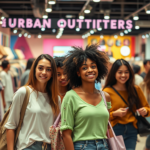
Urban Outfitters, a name synonymous with youthful fashion and edgy lifestyle products, has made waves in the retail industry. However, this vibrant facade often hides a darker narrative filled with controversies that have frequently tarnished its reputation. With an ever-curious consumer base yearning for authenticity, Urban Outfitters has stumbled into numerous pitfalls that have resulted in public outcry and negative press. From culturally insensitive products to marketing campaigns that border on offensive, the brand’s journey is not just about selling clothes; it’s a case study in the complexities of modern branding. In this article, we dissect the most significant scandals associated with Urban Outfitters, the consumer responses they triggered, and how the brand attempted to navigate these tricky waters.
The origins of Urban Outfitters’ controversies can be traced back to its marketing strategies, which, while aiming to be provocative and relatable to the youth, often veer into the realm of the unacceptable. The brand’s approach to edgy marketing raises essential questions about corporate responsibility and the boundaries of creative expression. Each scandal has led to broader discussions about cultural appropriation and insensitivity, which are increasingly important in the consciousness of today’s consumers. With each misstep, the brand not only risks losing customer trust but also finds itself scrutinized in the court of public opinion.
The Origins of Controversy

Urban Outfitters has enjoyed a reputation as a trendsetter, but this aureole of success has often made the brand blind to the consequences of its actions. The allure of youth culture provides fertile ground for marketing strategies that push boundaries, yet it can also create a disconnect if those boundaries are crossed. Beyond just fashion, these issues bring to light the complexity of representing diverse cultures within a commercial context. Over the years, even well-intentioned attempts at innovation have backfired spectacularly, leaving Urban Outfitters scrambling to mitigate damage. Understanding these origins is crucial to comprehend why certain items and campaigns elicited such strong reactions from the public.
Product and Marketing Missteps

Perhaps the most glaring examples of Urban Outfitters’ miscalculations come in the form of its product and marketing decisions. There have been numerous instances where the items offered for sale were seen as not only inappropriate but downright offensive. These controversies can be categorized into two major areas: offensive merchandise and insensitive marketing campaigns, both of which have drawn widespread criticism.
Offensive Merchandise
In a bid to stay fresh and relevant, Urban Outfitters has released products that many have deemed culturally insensitive. Here are a few noteworthy examples:
- A sweatshirt with a Navajo-inspired pattern, which sparked outrage over cultural appropriation.
- An “adult onesie” that featured a design reminiscent of Holocaust imagery, leading to severe backlash.
- T-shirts adorned with slogans deemed offensive to various communities, triggering protests by activists.
Insensitive Marketing Campaigns
Alongside product controversies, marketing campaigns have also brought Urban Outfitters under fire. The brand has often strived for a ‘cool’ factor but ended up trivializing serious topics. Some controversial campaigns include:
- Advertising campaigns minimizing mental illness and addiction.
- Unsolicited marketing response to tragedies that have left consumers feeling exploited.
Legal Troubles
The legal implications surrounding Urban Outfitters can be as controversial as its marketing decisions. The brand has been embroiled in several lawsuits which have further complicated its relationship with the public and its corporate ethics. For instance, litigations over copyright infringement have sparked discussions about originality and the values of commercial brands. These legal troubles do not just reflect the brand’s missteps, but they also give insight into a broader narrative about accountability in the fashion industry.
Some of the significant legal issues Urban Outfitters has faced include:
| Year | Issue | Outcome |
|---|---|---|
| 2010 | Copyright infringement lawsuit by a small clothing brand | Settled out of court |
| 2015 | Lawsuit concerning the use of Native American imagery | Settlement reached |
| 2018 | Trademark dispute with a photographer | Ongoing |
Consumer Backlash and Public Reaction
As scandals mounted, so did consumer backlash, significantly influencing Urban Outfitters’ brand loyalty and public perception. The amplification of these controversies through social media has streamlined a channel for discontented customers to voice their outrage. Indeed, social media has emerged as a pivotal platform where consumers share their perspectives, leading to trending topics and hashtags aimed squarely at the brand. Urban Outfitters has found itself center stage in a digital arena where accountability is continuously demanded and past mistakes are hard to erase.
The dynamics of consumer backlash have shifted, with hashtags frequently surfacing that encapsulate public frustration. This has forced Urban Outfitters to reconsider its marketing strategies and product offerings in real-time. The most significant impact has come from the fact that many young consumers are significantly more invested in the ethical implications of the brands they support. As a result, Urban Outfitters’ juvenile customer base has pushed for changes, demanding authenticity and respect for true narratives.
Attempts at Damage Control
In light of its controversies, Urban Outfitters has made concerted efforts at damage control to restore its image. Acknowledging their missteps is only the first step; translating that acknowledgment into tangible change is the real challenge. The brand has attempted to introduce more culturally aware practices in its marketing and product design. These changes are not merely reactionary but rather reflect an effort to engage meaningfully with the communities previously overlooked.
Some of the initiatives Urban Outfitters has undertaken include:
- Hiring a diverse team of consultants to better understand cultural significance.
- Launching campaigns focusing on social issues such as sustainability and mental health awareness.
- Enhancing transparency regarding the origin and manufacturing processes of their products.
Conclusion
Urban Outfitters’ scandals serve as a testament to the delicate balance brands must strike between edgy marketing and cultural sensitivity. As the retail landscape evolves, the brand’s ongoing challenges highlight the importance of understanding and respecting diverse narratives. While it has battled considerable public backlash and legal troubles, the lessons learned from these experiences may pave the way for a more responsible and forward-thinking approach. Ultimately, Urban Outfitters stands as a case study in the fine line between innovation and insensitivity in today’s commercial world.
Frequently Asked Questions
- What are the most notable scandals associated with Urban Outfitters?
- Examples of culturally insensitive products.
- Controversial advertising campaigns.
- How has Urban Outfitters responded to consumer backlash?
- Changes in product designs.
- Revisions in marketing strategies.
- Have any legal issues impacted Urban Outfitters’ reputation?
- Overview of notable lawsuits.
- Consequences of legal challenges on public perception.
- What role does social media play in Urban Outfitters’ controversies?
- Amplification of public reaction.
- Impact on brand management strategies.




